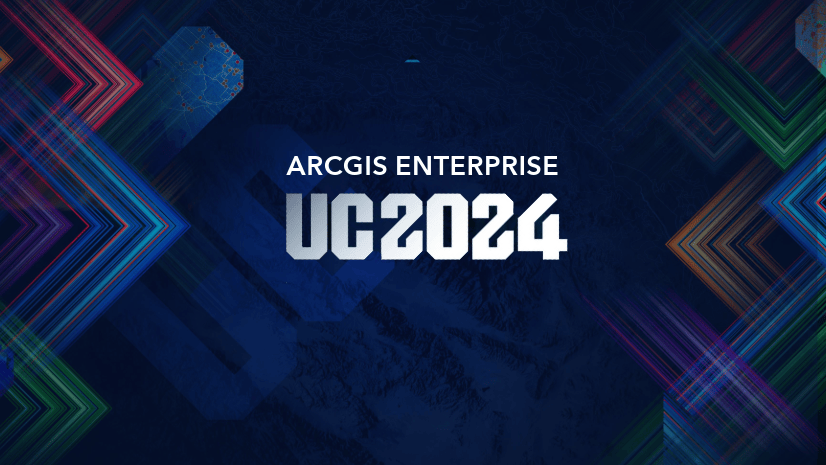The Esri User Conference provides a unique opportunity for ArcGIS users from around the globe to connect, learn, and explore the power of GIS. Before the ArcGIS Enterprise product team starts the countdown for the 2025 User Conference, we want to share some insights for a few frequently asked questions that we heard this year.
Q: My organization recently purchased ArcGIS Enterprise, and we are trying to get our plan together for architecting and deploying our system. Do you have recommendations on how to get started?
A: Yes, designing and implementing enterprise technology systems is a collaborative effort that starts with a shared understanding of organizational IT infrastructure, and how it supports business objectives. The ArcGIS Well-Architected Framework and Architecture Center website offers foundational information like ArcGIS system pattern examples, best practices, and diagramming toolkits to empower IT professionals, architects, support team members, and GIS professionals to collectively design and deploy a GIS tailored to their organization’s needs.
Esri also offers and maintains a variety resources– from instructor lead courses to self-service documentation– to help you decide the best way to operate, customize, and scale your ArcGIS Enterprise deployment as organizational needs change.
Explore the benefits of starting your system architecture journey with ArcGIS Architecture Center resources in our blog.
Q: How do I prepare for an upgrade to 11.x?
A: We recommend considering the version of your current deployment, the upgrade that best suits your needs, then assessing the level of effort required to get there.
Our blog, “Preparing for your upgrade to ArcGIS Enterprise 11.x” provides a comprehensive overview of the ArcGIS Enterprise product lifecycle, under-the-hood technology enhancements of 11.x, and steps you should take to have a thoughtful upgrade. If your deployment is Enterprise 10.9 and earlier, consider upgrading to ArcGIS Enterprise 10.9.1 before upgrading to 11.x, to facilitate a smoother transition.
Every journey to 11.x is unique; once you know your destination, you can consider the path forward. Explore our series of “what’s new” blogs to get inspired.
Q: Can distributed collaboration be set up between ArcGIS Online and ArcGIS Enterprise when ArcGIS Enterprise is behind our firewall?
A: Yes, distributed collaboration empowers users to extend the reach of their GIS content beyond their organization while maintaining complete control over access to your organization’s authoritative system of record.
To support a collaboration from an ArcGIS Enterprise deployment behind a firewall, outbound access through port 443 in your firewall to ArcGIS Online needs to be established. To get a bit deeper, this is because Enterprise will be making requests to Online and Online will only be responding – Online will never be making requests of Enterprise. This workflow enables you to share copies of ArcGIS Enterprise feature layers to the collaboration workspace to facilitate project collaboration through web maps, web apps, and mobile apps .
Learn more about creating and using distributed collaborations in this video and our documentation.
Q: Is metadata included in distributed collaboration?
A: ArcGIS Enterprise 11.3 enables users to share content accompanied by item and sublayer metadata with collaboration participants. Along with sharing the metadata, the sending organization can edit the metadata and sync the changes for collaboration participants to view. This enhancement makes the content you share more useful by enabling collaboration participants to reap the benefits of your authoritative metadata, while minimizing the possibility of errors and discrepancies.
Learn more about content sharing in our documentation and explore what’s new in ArcGIS Enterprise 11.3 in our blog.
Q: Users at my organization have many software systems to do their work. If my organization uses both ArcGIS Enterprise and ArcGIS Online, can I use the same username and password to access both?
A: Yes, one way you may support this today is by using enterprise logins which allow your users to access different internal systems using the same username and password. If your organization is SAML or OpenID Connect, both ArcGIS Enterprise and ArcGIS Online can be configured to allow authentication through these external identity stores. This means users will be able to login to both Enterprise and Online using the same credentials. However, these are still separate organizations, each with their own identity stores and set of associated content. You cannot log in to ArcGIS Enterprise and expect to see the same content as when you log in to ArcGIS Online. Please keep in mind, users will need separate licenses for both systems in order to do so.
Explore more details in our documentation.
Q: My organization uses both ArcGIS Online and ArcGIS Enterprise. I’ve noticed that ArcGIS Online updates more frequently with new functionality that I don’t see in ArcGIS Enterprise until later. Why is there a difference and how can I take advantage of the most recent new features?
A: ArcGIS Enterprise and ArcGIS Online have similarities, as well as differences, to support organizations that want bring GIS into their workflows at the level they need.
ArcGIS Online is software as a service (SaaS) that is maintained by Esri whereas ArcGIS Enterprise is a self-hosted software. that provides many unique benefits, such as a high level of control and configurability for organizations that need it. As foundational products within the ArcGIS platform, ArcGIS Online and ArcGIS Enterprise are designed to seamlessly integrate with other ArcGIS products, including each other.
Due to ArcGIS Online being a SaaS, new features are delivered immediately to users via a system-wide update. By comparison, as self-hosted software, new features are made available in ArcGIS Enterprise when the deployment is upgraded. While the majority of new functionality may come to ArcGIS Online first, sometimes ArcGIS Enterprise has the new functionality first. Working closely with your organization’s system administrators to ensure your ArcGIS Enterprise deployment is upgraded on a regular basis will help your organization continue taking full advantage of the unique benefits of both products and maximize its investment in GIS.
Though ArcGIS Online and ArcGIS Enterprise work together, they are separate products with their own unique capabilities, product lifecycles, and more. Learn more about product lifecycles for Enterprise and Online on our technical support pages; also, explore how ArcGIS Enterprise and ArcGIS Online are better together in this blog.
Q: How can we most effectively migrate content, such as Experience Builder apps, between ArcGIS Enterprise environments (development, staging, production)?
A: You have a variety of options for moving content from one ArcGIS Enterprise environment to another, such as promoting items from development or staging to production.
The ArcGIS REST API offers the export and import group content operations to move content between environments. These operations allow you to export and import group content from an ArcGIS Enterprise organization as package and are especially useful for promoting content from development or staging environments to production.
Alternatively, the ArcGIS API for Python includes the clone_items() and argis.gis.GroupMigrationManager.create() and argis.gis.GroupMigrationManager.load() functions.
The clone_items() function is a tool to consider if you are migrating all your content from one environment to another.
The argis.gis.GroupMigrationManager.create() and argis.gis.GroupMigrationManager.bulk() functions are another mechanism to export and import group content from one ArcGIS Enterprise environment to another as packages. These functions are good to consider when you will only be migrating a subset of your content.
Learn more about ArcGIS Enterprise migration strategies in our product documentation and blog
Q: How do I migrate my ArcGIS Web AppBuilder apps to ArcGIS Experience Builder apps?
A: In preparation for ArcGIS Web AppBuilder retirement in 2025, we have curated a collection of documentation, tutorials, and videos to assist you with migrating your content to ArcGIS Experience Builder, understanding the functionalities the application, and familiarizing yourself with capabilities and widgets now available to you.
Start taking advantage of the modern and responsive design, improved user experience, and new widgets in ArcGIS Experience Builder with these curated resources.
Even though the 2024 Esri User Conference has come to a close, you can still connect and collaborate with thought leaders and geospatial professionals from around the globe in the Esri Community and continue to transform your workflows with ArcGIS Enterprise all year-round by exploring our Esri User Conference Q&A page.




Commenting is not enabled for this article.